[Missed the first two articles in the series? Get caught up with Part One and Part Two.]
The team of players in my gaming networks knew it was going to happen eventually. We formally put Race for Glory—the High Frontier 4 All variant with its own dedicated rulebook, the “essentials only” version of the game with slightly streamlined rules and about half of a normal game’s turns—on the calendar for two Mondays in January and February, while I set aside time for a solo play of the game in-between those two group plays.
Let’s start with the rulebook for Race for Glory. It’s a dense read; like other manuals included in High Frontier 4 All, the Race for Glory rules are rich with footnotes. Half of the manual is a tutorial using the Race for Mars variant of the Race for Glory rulebook. (High Frontier 4 All might have the most gameplay variants of any game I have ever played, which is saying something given that I’ve reviewed more than 500 unique games for this website and played hundreds more beyond that.)
The tutorial helps get players directly into the action, thanks to a three-faction setup featuring the crews of the “CRP” (essentially, China), NASA, and the European Space Agency, or ESA. It’s a fun read, made more interesting by the fact that the manual’s authors (Al Cann and Simon Ng) work hard to give personalities to the imaginary players operating each faction. At varying points in the tutorial, it feels like one is both walking through a game and streaming an episode of a dramatic, sci-fi themed TV show.
That makes Race for Glory an exceptional entry point for a larger game that is initially shocking in terms of its density. Here, the three factions are set up to run a partial game that will last 25-30 turns (a full game of High Frontier 4 All lasts 48 turns, or years). The Race for Glory manual features five variants, a mix of competitive and cooperative setups that can be played solo or up to as many as six players (five out of the box, six with a separate expansion).
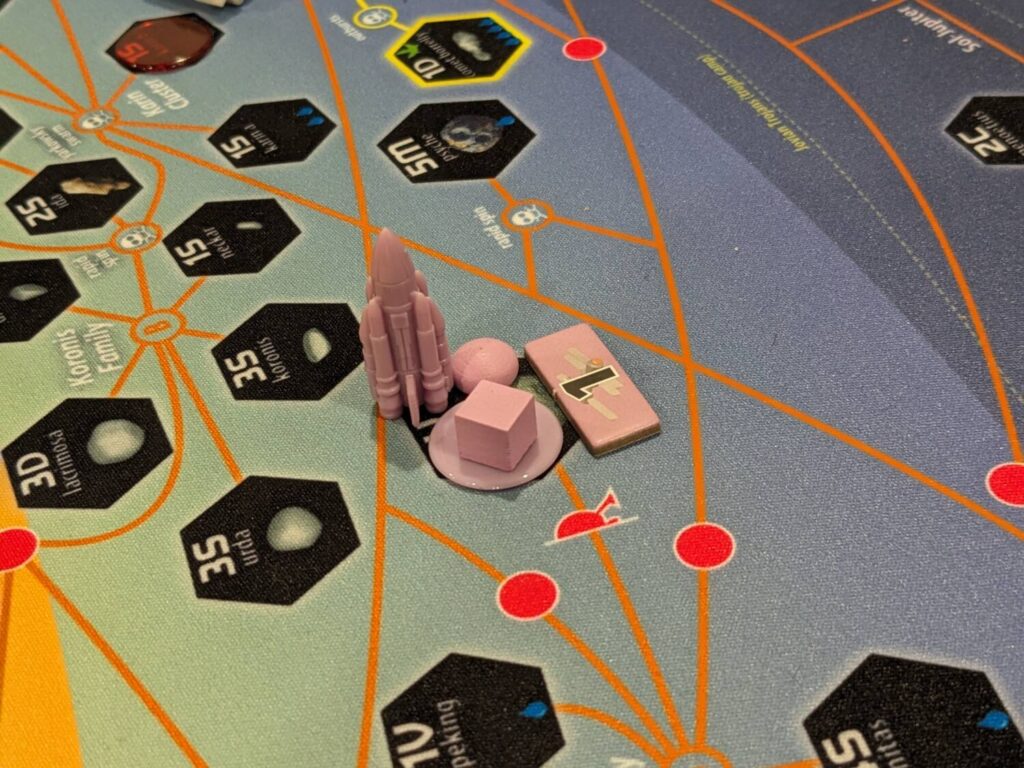
Race for Mars
The Race for Mars variant was our pick for the first go because it limits some portions of the main game. With about 25 turns, players are pushed to focus on the acquisition of patent cards (used to later become parts of each player’s Rocket Stack, a mix of thrusters, robonauts and refineries) and building a rocket or two to make trips to Mars. In High Frontier 4 All, Mars is actually a cluster of three landing sites that form the focus of the tutorial and have scoring conditions unique to this variant.
The tutorial is completely scripted across 28 turns, so if players wanted to just play the tutorial aligned with the script, that’s an option. We originally set up our first play with four players, so we intended to go offscript…but then one of our foursome bailed, leaving us with three players, so we instead chose to pivot to using the game’s tutorial setup but we left everyone to make independent choices using the same three factions featured in the tutorial.
Independent choices made by our playgroup ended up being the right move, in part because of the warnings the book makes about letting players make a lot of mistakes in their first run. Almost on cue, we began to stumble around a bit. Patents are put up for auction by the active player, which makes them the temporary owner of the patent…if the auction is won by the active player, they pay for cards to the bank in “aqua”, the game’s multi-use currency that can buy cards, fuel rockets, serve as cargo for ships going on longer missions, and likely other purposes that we haven’t seen yet.
But if the active player loses an auction, they are paid by the player who won the patent. This led to an interesting series of decisions by all three players in my first run. We regularly overbid for patents, setting up other players for hoarding large pools of aqua to use later for their rocket launch actions. While the game doesn’t have a hand limit, it does have a hand limit when players want to participate in auctions (the “academia hand limit”, of four cards)…so we learned that the best time to auction cards you really do want might arrive when opponents all have four hand cards and are locked out of a particular auction.
The patent cards are wild! Lots of games feature flavor text; think of any of your TCG/CCG cards with fun character names, flavor quotes, or epic images of a person wielding a sword. In High Frontier 4 All…those pictures are dry, science-heavy toast, but the kind of toast that creates immersion in a way that I can’t think of in any other game NOT published by Ion Game Design.
One of the robonaut cards is called “solar pumped MHD exciplex laser robonaut.” Say that five times fast! But there it is, in all its glory, featuring loads of big words, fancy computations, and an astronaut drawn to show the scale of the size of the robonaut. To say that High Frontier 4 All is “nerd heaven” is a massive understatement.
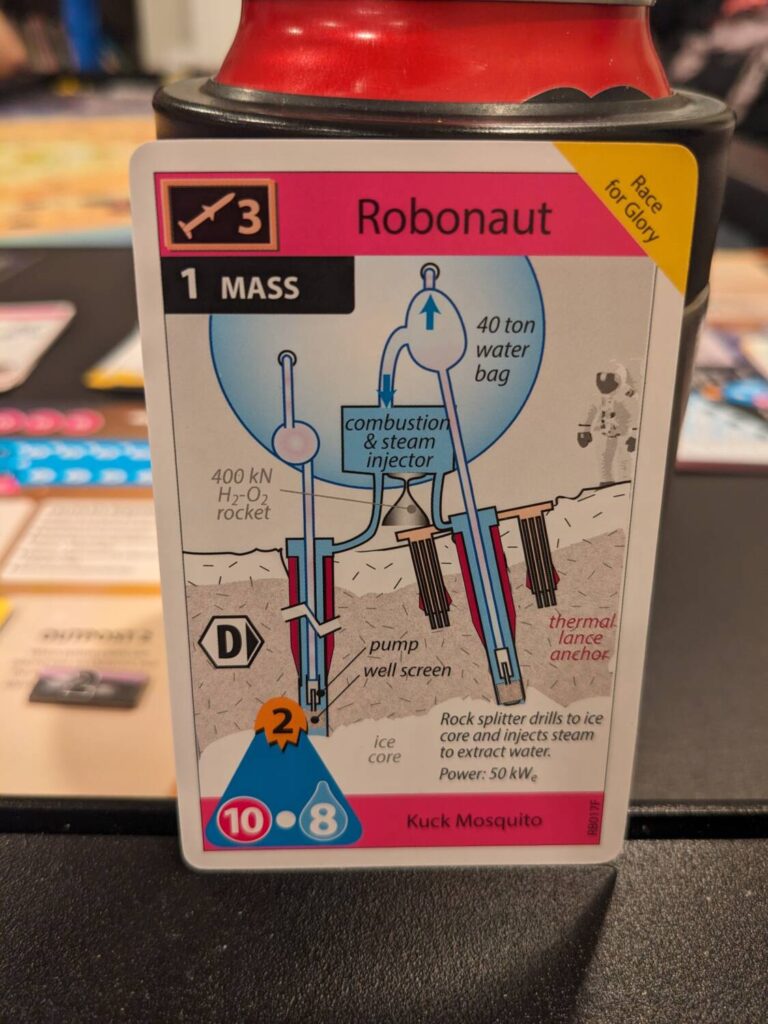
Race for Stacks
Players build up a hand of patents for two reasons—the first, and more exciting reason, is to compile the parts needed to build a rocket that will fly to Mars.
This was the best part of the tutorial. It was great to see how the auctions and draft choices lead to the build—composed of a Rocket Stack of cards, with the only rule being that the rocket needs a thruster to get into space and land onto the Mars surface. Everything in this portion of the game (years 10-20, roughly) utilizes the patent cards, the crew card (showing both a thruster of its own, along with each crew’s variable player power), and the fuel track.
Our previous experience with computing dry and wet mass in Space Diamonds kicked into gear. High Frontier 4 All is a technical affair, math-heavy at times, as players try to figure out the most efficient way to cross the galaxy with just enough fuel to take off, navigate “burn” spaces, then land on a planet’s surface. The mid-game of Race for Mars has a lot of nice meat to it, thanks in large part to the patent card draft.
I need to keep my dry mass low, so that I can buy fuel that carries my stack a lot farther. That means I want a really light thruster…but I really want to make just one trip to Mars, so that means taking everything on the first pass. Ahh…but if I do that, the dry mass of the crew, the thruster, the refinery and the robonaut gets me to a dry mass of something north of 10. Then I have to add fuel, which means this will make my wet mass crazy inefficient…
All the questions generated by this part of the game were awesome. While I didn’t love the way money/aqua works in the first 10 turns—the most efficient way to make money, weirdly, is to win patent bids for low or no aqua, then sell them using the “free market” operation to earn an automatic three aqua, just isn’t very interesting.
I see why these controls are in place…it takes time for a government to secure the patents and the fundings to put an operation into space. Fine. But as a game mechanic, I wish designer Phil Eklund went with an approach that just granted players more starting aqua that could only be used as fuel. There’s more tension in the game’s version than my preferences, but I just wanted to get my hands on a rocket stack.
After figuring out which cards to add to the rocket stack, players have to “boost” their parts into Low Earth Orbit, or LEO. Because NASA has a special power that gives them an aqua on any player’s boost action (“feels real, like America is taxing everybody”, said one player about this power), there’s a shared incentive to make the boost action as efficient as possible, limiting NASA’s ability to milk poor decision making. Shuffling cards between LEO and the rocket stack space is a free action, so players can cobble together the build they want at just the right time.
One other consideration: boosting costs one aqua per dry mass on the equipment you want to boost to space. Money/aqua feels really limited at these moments; I need money to bid on more cards, I need money to put patents into action, I need aqua to fuel my rocket, and I might want to bring fuel as fuel tanks (cargo) to extend my rocket’s ability to stay in space for a longer duration. GAHHHHHHH!
At this point, you’ll say the same thing one of our players said about the High Frontier experience: “this feels more like a simulation than a board game, in a good way.” I agreed. There are plenty of times I just want to play a game like Andromeda’s Edge where I’m not managing the business of launching my fighters…because I want to be in the business of shooting down aliens and running up tracks. High Frontier 4 All is a niche play here as well…the best player has embraced the real-world science of gathering patents to boost rocket parts into space, all in the hopes of landing a probe on a distant asteroid to build a factory and delivering new-school, “Black Side” patent technologies back to Earth before the end of the game.
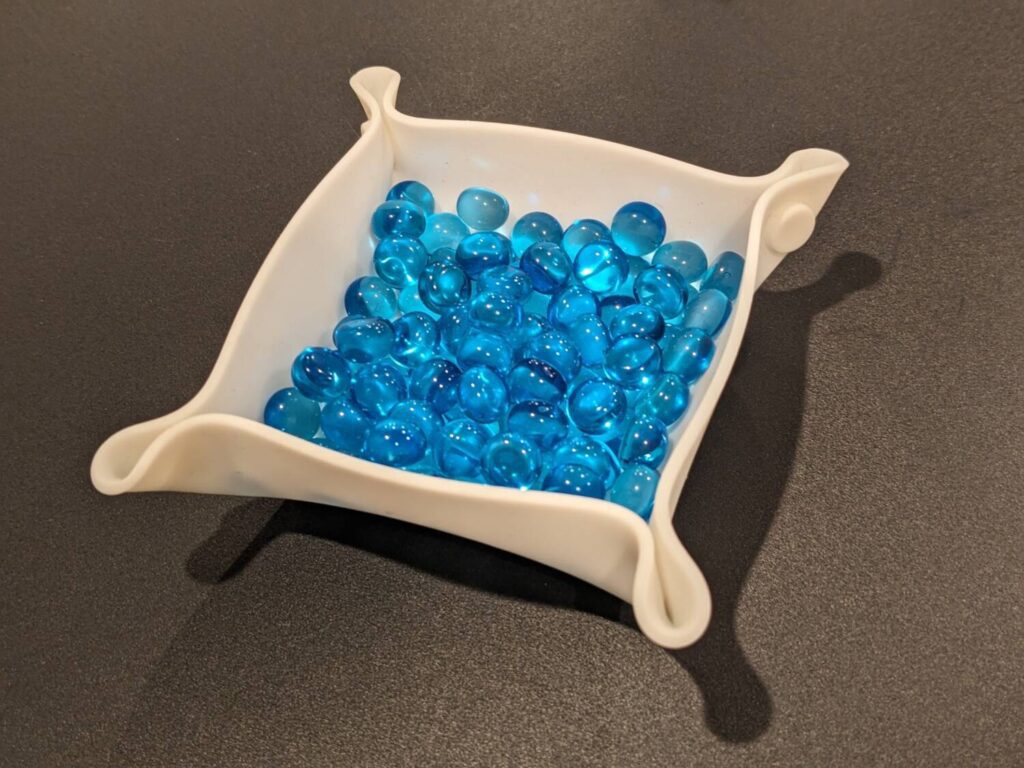
Race for Fuel
“Guys…I think I messed up on gas.”
My buddy Wil was looking at his predicament and decided that he was going to go for it all…and try to land on Mars by conducting a “hazard roll” on two space passages that were a little hairy.
Wil left LEO with a wet mass that only allowed him to do a three-burn move from LEO all the way to Mars. Wil (playing as ESA) didn’t plan this move as well as he would have liked…so he didn’t have four extra aquas on his playmat to attempt “Failure is Not an Option”, or FINAO.
All this mambo-jumbo makes sense to the game’s audience, but let me simplify this for the masses: High Frontier 4 All is a “gas game”, in the words of my review crew. Efficiently planning missions around fuel, even in Race for Glory variants, seems like the biggest part of how full games of High Frontier will go. That starts with having just enough gas to get from point A to point B, then taking refuel actions to ensure you can make the next big jump to another site.
Wil didn’t do that.
Wil made one small mistake on the math, so he doubled down on the mistake by taking his chances by performing two die rolls with a standard d6. The “Aerobrake Path” spaces scattered around the Mars landing sites provide a juicy alternative to attempting a Lander Burn—the Aerobrake Paths are faster and did not require additional fuel from the space where Wil’s rocket was currently sitting.
So, Wil made his two die rolls. His original plan was to just roll once, then spend the four aqua to ensure he safely passed through the second Aerobrake Path. But Wil was fresh out of aqua.
He made the first die roll…and the result was a one. This meant Wil’s ship exploded in the Aerobrake Path, which killed the mission, Wil’s rocket parts, and his spirit. This is a family-friendly tabletop website, so I’ll take the high road here and note that Wil shouted a cargo hold’s worth of words we can’t reprint.
“So do I lose everything?” Wil asked.
“No,” I said. “You keep the patents—the ideas that you bought earlier behind the science—so your rocket is toast but the cards in the rocket stack just go back in your hand. You can boost them again later.”
Of course, at this stage, Wil really did lose everything, because in a shortened version of the game, it would have taken too long to get the money (aqua) together to rebuild his rocket then launch again before time was up. It was a tough moment, because space exploration is already a gamble (although I’m not sure if unmanned rocket missions fail at a rate of one in six or not) and to spend the first half of the game building a rocket that never made it to Mars might be a table-flipping moment for some people in my network.
For me personally? Between my two plays of the Race for Glory variants, I really enjoyed mathing out my moves with just enough fuel to land and make a claim for a site on Mars. I also like the benefits offered with a completed factory; getting seven aqua from the planet to throw back into my rocket was a blast, then figuring out a way to lift off and fly a manned mission is quite satisfying.
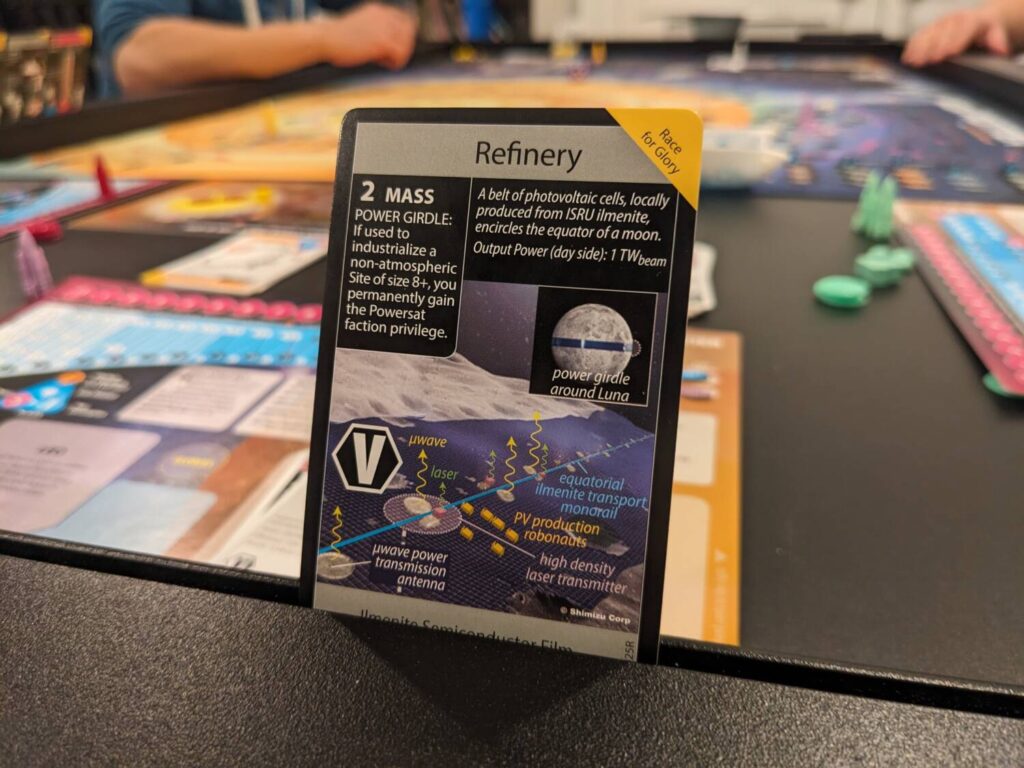
Race to the Top
For my second game of Race for Glory, we played the Race to the Top variant—essentially, the core High Frontier 4 All game, accommodating 1-5 players in a competitive format, with a full 48 turns instead of 24-30 like in the Race for Mars variant. The main change here, besides the additional turns, is that Race to the Top uses the whole map of space, not just the corridor that includes Earth and the Mars landing sites. I house-ruled the number of turns, and set up our second game to be a 36-round experience.
During this second play—which was really my fourth overall play of a High Frontier 4 All game, if you include my two plays of Space Diamonds—almost everything about the lighter rules load kicked in.
That starts with High Frontier 4 All as a “gas game.” Everything I did in the early game was aligned to two factors. The first focus point: trying my best to launch with a refinery, robonaut, and thruster, along with my crew so that I could establish both a factory and a colony on my first mission. Second: gas. I tried to win enough auctions or take the income action of one aqua to get just enough gas to fly to Vesta, a location in the Ceres Heliocentric Zone that ended in the letter V.
This last point only occurred to me after I won a few auctions. If you want to score the bigger points in this game, you have to focus on “Black Side” patents, aligned with the “spectral type” of the patent cards (one of six letters) and the landing site where a player has a factory. Long story short—once I had a robonaut that I liked, I noticed it had a big V on the card…so my focus then became a drive to ensure I did everything based on landing at a site that was larger than one, and had a V in the description.
There’s a lot more to it than these steps, but this is mainly to highlight that High Frontier 4 All’s dense list of rules was starting to click. Of course, spending many hours reading five different rulebooks, watching tutorial videos, then playing a game a few times will do that for a guy. Now, it was starting to pay off.
And what a difference it makes…because the other four players in our five-player game of Race to the Top had real struggles. Three of them (yeah, that number felt high to all of us as well) failed hazard rolls and watched their hopes, ships, and dreams explode high over the surface of many different planets, asteroids and other “celestial bodies.” One guy mis-mathed (yes, a word we created during this play) the amount of fuel he needed to get where he wanted to go, so we had to watch as he voluntarily jettisoned parts of his rocket to make it light enough to eventually land on a 1S entity, where he missed on prospecting rolls and “busted” two sites on back-to-back turns.
Players were winning auctions for two or three aquas, then using free market operations only to get their spent money back. One person misused their crew power and didn’t use the FINAO discount he got as a result. We only had one or two rules errors, but they were noticeable, like when a player thought setting up a colony was an action, not a free action like the rules dictate.
Overall, the Race to the Top play locked things in for me. The next question? Who will be left from my network willing to join me for the plays of the full, “core” game?
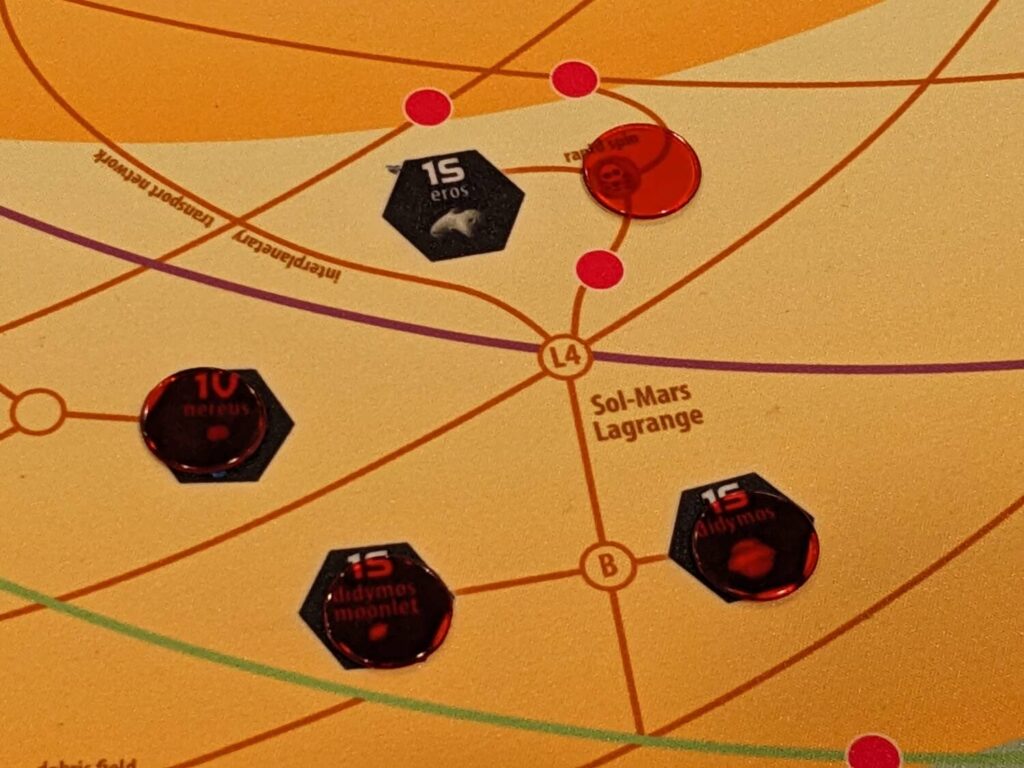
What’s Gonna Happen Next?
In our final piece on High Frontier 4 All, the mission is clear: play the full game, no restrictions, twice, maybe three times, to finalize a review and a rating.
Even getting this far was both an incredible challenge and a fantastic victory. The Race for Glory variants really got me thinking about how to build a small group of enthusiasts (one player jokingly referred to HF4A enthusiasts as “cultists”, and with this ruleset, I get why).
The game is such a niche play, both as an investment for a gamer’s time and the investment in any one single property. Much like it has been a challenge to find regular 18xx gamers to join in-person plays, High Frontier 4 All stakes its claim right after you open the box: take it or leave it, pal!
Some of the players in my review group have been transparent: they are out. One of the players who ran out of gas during our second game was on his way out of my house at the end of the night when he turned to me with a look.
“It was interesting…and it was absolutely not for me,” he said. “But I’m excited to hear what everyone else thinks when you write the review.”
My buddy Wil crashed in our first Race for Glory play, then ran out of gas on his second play, ruining both of his games. “But I just want to try it one more time…I just want to land on a planet!” he said. He would probably tell you he made some risky decisions; that was certainly my viewpoint. But I liked that he was willing to own that and wanted to jump back in the fray while he still knew all the rules.
Me? I’m in. Part of that is because I’ve made a commitment—I want to see this thing through. Now that I know how to play the game, I just need to find the time to play the full game, again, quickly, before I forget everything I have learned.
There are some things I really love, particularly in the planning process tied to missions, and the procedural elements of getting the right stack to the right location to “cargo transfer” rockets into outposts and work towards victory points. And some of the auctions have been more interesting than others. There’s a nice sense of fulfillment when you see a plan come together in this game, more than maybe other games, because the early game is such a slog.
That initial auction process? I’m still not sure where I land on it, but I know it takes too long. We were still auctioning patents at the 80-minute mark of our second Race for Glory game, and that took about a dozen rounds. I love auction games, but even I was getting fatigued by the time I had enough gas to get my rocket into space in that game. I was noticeably irritated by the time we really got ships off the ground…so, part of my frustration is tied to player count. I don’t think I would play a full game of High Frontier 4 All with more than three inexperienced players, or maybe four if everyone knew what they were doing.
But those are problems for next month. So far, so steady!


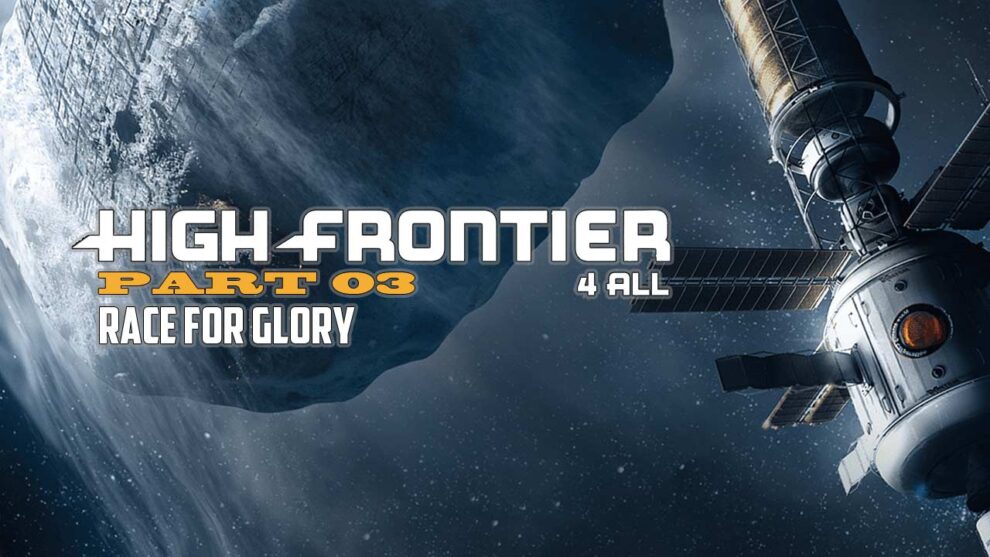

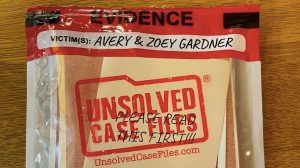






Very much enjoying this HF4A series, and it sounds like you’re having fun while dealing with the uncertainties of the patent market, aqua economy and the risk of rapid unscheduled disassembly. In my experience, failure is ALWAYS an option, which is why much of the game is an iterative process. Hopefully, an engaging one.
Some suggestions for your upcoming game(s):
Buy a solar sail early, and use it in the inner system to snag Glory Tokens and bring them home for extra VPs. The missions need to be crewed (mass 1), but the solar sail benefits from increased thrust because they’re low mass, solar-powered and are immune to rad rolls. Your crew is not, however, so don’t travel during Red Season. 😱☠️
Rad roll risk can be mitigated if you’re willing to spend the time. Burn to the Cycler with your efficient thruster and rad-sensitive equipment (rad hardness L4 burn > Moon flyby +1 > burn to Sol-Mars L4 > Hohmann on Light Blue Path > Mars flyby +1 > Aerobrake > Mars orbit burn > LMO.
I just reread what I wrote and understand why this spacesim doesn’t appeal to everyone. Guess it’s just the way I’m wired.
Best of luck. Looking forward to your next installment. 🖖
Excellently written as always.
There are alternatives to the initial auction money management. The pre made rockets of the “Tools 1” box and the quick rules where the first 12 turns are taking turns picking patents for free (without bonus cards from supports) You can find the exact rules for it in the rulebook somewhere.
/Jon